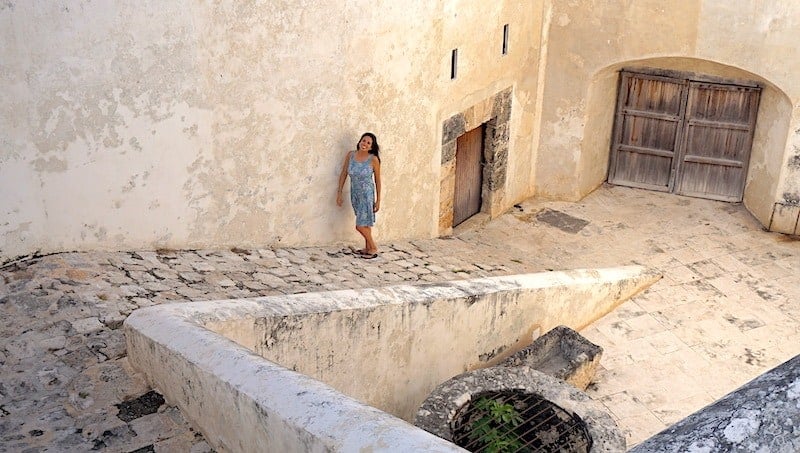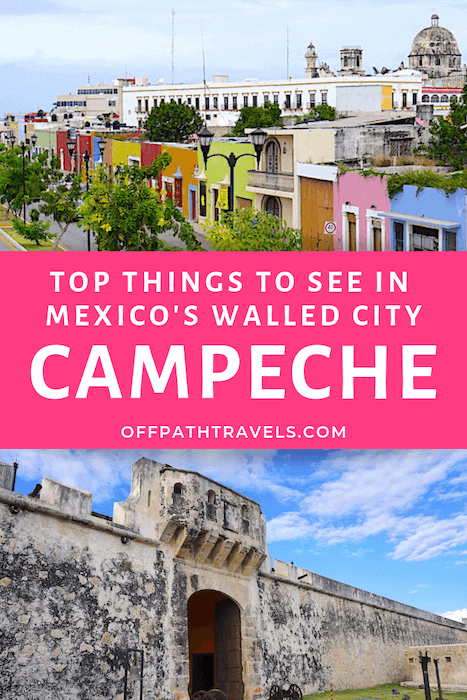Fending off invaders used to be a large problem for the historical city of Campeche, Mexico. But in the 17th century, that all changed. The city fortified itself by erecting large walls around the entire city center and adding numerous forts near the outskirts of town.
These walls have been wonderfully preserved and make for a unique tourist destination. UNSECO recognized the importance of them and the city center by designating these Campeche points of interest as a World Heritage Site.
You can walk along the top of the walls, see the rusted cannons, and check out the view from the eight bastions. Come to Campeche and put yourself in the shoes of the defenders of the city!
Inside of the surrounding walls, the city’s colonial architecture is full of brightly-painted buildings and wonderful facades. The city itself, however, is quite sleepy most of the time. But it still has plenty to offer to make a nice vacation. There is a nice row of restaurants catering to tourists along a pedestrian walkway, many cantinas (small bars) to let loose when the mood strikes, and plenty of other choices for food and drink all around town.
Or if you’re looking for a more cultural experience: Excellent museums on Maya architecture, Campeche history, and a former prison are waiting for your visit. As are archeological ruins at Edzna, multiple forts near the city, and other fun activities beyond the walls.

As you can tell, Campeche’s points of interest are vast. We’re going to cover them in three parts:
Part 1: History & Exploring the Defensive Walls & Bastions (this post)
Part 2: Other Things to Do in Campeche City Center: Restaurants & Parks
Part 3: Venturing Beyond the City: Edzna Ruins, Forts, and Places to Have Fun
Brief History of Campeche
The city of Campeche, like most of the Yucatan peninsula, was inhabited by Maya people for centuries prior to the Spanish Inquisition. The region was then known as Ah-Kim-Pech. Sometime in the 12th century, the majority of the Maya people left the area. But a fairly large population remained. They were later conquered and enslaved by the Spanish who took hold in the 16th century.
Soon thereafter, the Spanish had the tables turned on them. Pirates and other enemies of Spain (often hired mercenaries) constantly attacked this vital port city. After decades of pilfering and living constant danger, the Spanish erected the massive walls reaching 26 ft (8 m) high and 8,400 ft (2,560 m) long surrounding the entire city center. The walls include eight baluartes (in English: bastions; angled areas allowing for multiple defensive lookout points) and four large doorways. The construction lasted 18 years and completed in 1704.

The interior, protected area is full of colonial architecture and colorful buildings. Although Campeche is much smaller, the colors remindeed us of one of our favorite cities: Oaxaca de Juarez. Getting lost in the rows of vibrant houses, restaurants, and shops is an experience in itself. So feel free to wander around! After all, you’ll eventually just hit a wall and can turn around to get back.
Here’s our list of our favorite Campeche points of interest inside and along the city walls:
Campeche Points of Interest
Puerta de Tierra, Baluarte de San Francisco, & Baluarte de San Juan
Puerta de Tierra (Earth Door) is one of the most magnificent entrances to the city, located in the middle of the southwestern wall. It is a large entryway with elaborate doors and a small museum (Museo de Sitio en Baluarte) inside, with a mock pirate ship and a small grass courtyard outside. A sound and light show is hosted here Saturday nights at 8 pm for $50 pesos ($2.50 USD) per person.
But best of all, for $15 pesos per person, you can climb to the top of the doorway and have access to almost half of the walls. This was one of our favorite activities during our entire visit to Campeche and the surrounding area. After paying the fee, a guard lets you through an old, wooden doorway. Then you go up a set of stairs and you are on top of the walls!

Baluarte (bastion) de San Francisco is immediately in front of you once you climb the stairs. The rusted cannons lay next to their old stations. Put your head in the lookouts and pretend you are protecting from invaders at the superior vantage. Kristina stuck her head into one bastion and came out laughing. I thought it was weird since there were no windows in that one. Ends up, she found a 300-year-old toilet! What a great way to relate to the defenders on a different level. (The toilets are not functioning.)
Once you’re done there, turn around and walk the opposite direction along the narrow pathway at the top of the walls. You’ll end up at Baluarte de San Juan. It is another great lookout area with views that stretch about 270 degrees around. From the top here, you can see a pedestrian walkway and park on the inner side of the wall. When you’re back on street level, come back here to go for a stroll or grab an ice cream at one of the small restaurants or vendors.
Eventually, you’ll need to wander back toward the same door you entered in through. We did this as the sun was setting and we spent way too much time up there. The guard didn’t come back right away, so our blood-pressure went up a tiny bit. We loved these walls, but certainly did not want to be stuck on top of them!
We scrambled around to some of the other points of interest making sure we didn’t miss another exit. After exhausting all options, we thought back to our recent stop at an incredible beach in Oaxaca to slow down for a moment.
Then we came back to the original doorway and saw there was a large bell nearby. Although we were certain you usually shouldn’t have to ring it, we gave it a few smacks and the gate-keeper came right out. Finally, we were set free from our start to Campeche points of interest.

Baluarte de Santa Rosa
This baluarte (bastion) has been separated from the other parts of the wall and stands alone in the middle of roadways. It has free access to the top with many lookout points though. And there is a free small museum (one room with rotating exhibits) inside. It’s a worthwhile stop as you venture around the city, but you don’t need to spend much time here.
Baluarte de San Carlos & Museo de la Ciudad (Museum of the City)
Keep circling clockwise around the city to access this point of interest located on the northwest corner of the walls. It houses the Museo de la Ciudad (Museum of the City) which used to serve as a prison. Entrance is free and you can get through the museum’s three rooms quite quickly.
The museum has a lot of great history about the inhabitants of the city, both antagonists and protagonists. Even a full set of armor and a scale-model of the city. Not a main attraction, but a Campeche point of interest which helps understand more of the historical past.
Climb down into the cellar to see where the prisoners were kept. Shackles are on the wall with a manquein prisoner tied to them. Kristina let out her inner prison guard here. Head up the stairs to see a nice ocean view.

Ex-Templo de San José
Just inside of the walls from San Carlos is a magnificent ex-temple. This old church is now used for a variety of functions – serving as a holiday market when we visited in December. The front facade is impressive, but not much remains inside. Nonetheless, this landmark is visible from the walls far away and is a nice quick stop during your tour of the city.
Baluarte de la Soledad, Museo de Arquitectura Maya, & Puerta de Mar
Puerta de Mar (Ocean Door) is a large entrance to the city which leads to the waterfront board walk. The area is nice, but it’s a city without a beach and we missed the wide stretches of beaches in Puerto Escondido a little bit. But many events and weekly markets are hosted here.
The Museum of Maya Architecture is full of interesting Maya relics, including many jade pieces, stelae, glyphs, pottery, and other cultural pieces. $55 peso entrance fee. The Baluarte de la Soledad is accessible from the museum. Both of these are highly reccomended Campeche points of interest.

Centro Cultural “El Palacio” & Museo de Fortificaciones, Comercio y Navegación
The Cultural Center is on the northern side of the main plaza and is well worth visiting. Many rooms throughout the wide structure combine to create an educational museum. Information about the fortifications, commerce, and ocean navigation are all within. Our favorite pieces included numerous scale-models of ships from centuries past and a great lookout point from the top balcony facing the plaza.
There are free guided tours so make sure to check the schedule to come by and see what all of the fuss is about. This building is exceptional as well. And one balcony overlooks the main plaza; perfect for photo opportunities or people-watching.
Jardin Botanico Xmuch’haltun
On the northeast corner of the walled area is a small botanic garden. The entrance fee is $15 pesos. Has quite a few species endemic to Campeche, as well as a small pond with fish.
That wraps up a tour of Campeche points of interest: the city’s walls, bastions, and museums! Our recommendation is to start at Puerta de Tierra and wrap around clockwise all the way to the Cultural Center. You’ll get to explore many bastions, walk along the top of the walls, and gain an understanding of the city’s rich history on a much deeper level.
Keep reading about this wonderful city in the next two parts of this guide to Campeche:
Part 2: Other Things to Do in the City Center: Restaurants & Parks
Part 3: Venturing Beyond the City: Edzna Ruins, Forts, and Places to Have Fun
Have you been to a heavily fortified city before? Leave us a comment to share your favorite one!
Like This Post? Pin It!


